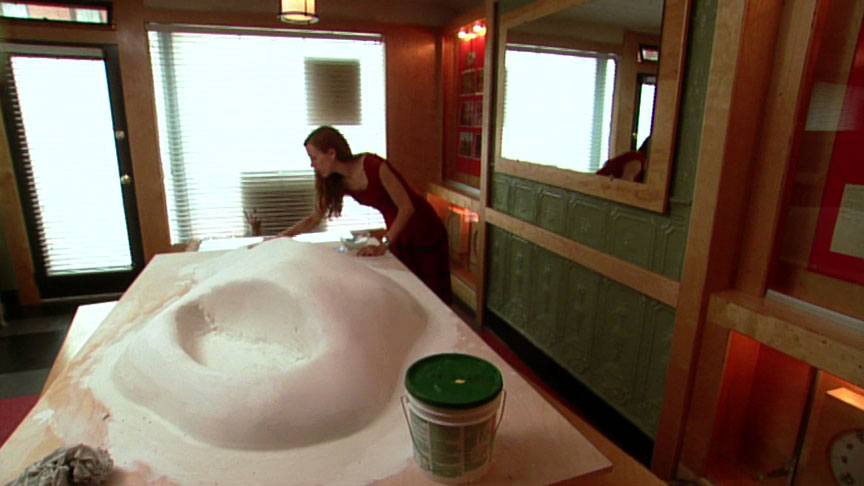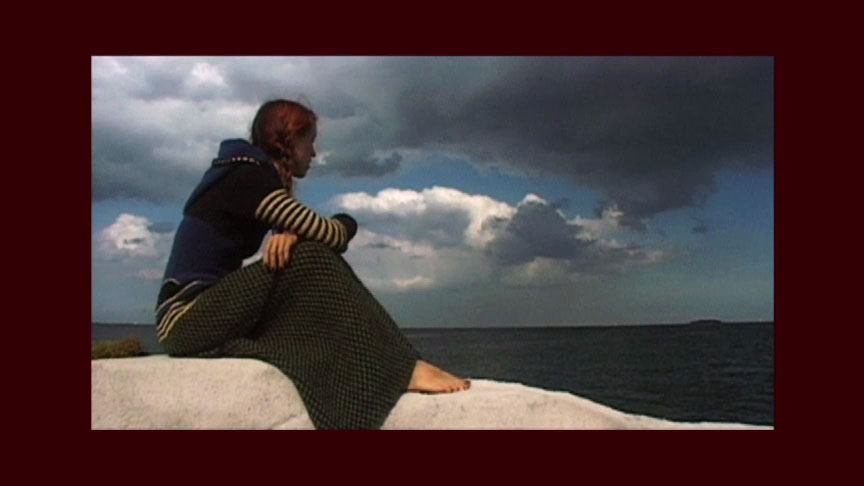Interview
“Pocket Property”

Production still from the Art in the Twenty-First Century Season 1 episode, Consumption, 2001. © Art21, Inc. 2001.
Andrea Zittel discusses her 1999 installation A-Z Pocket Property, a 44-ton floating concrete island anchored off the coast of Denmark, on which the artist lived for one month as an experiment in escapism and isolation.
ART21: How did you come up with the idea of the Pocket Property?
ZITTEL: I guess, when I was working in New York, I found that I was mostly drawn to these very small, contained capsules that would go inside of preexisting architecture. Moving to L. A. completely changed the scale of my thinking, and I started to become much more interested in creating environments, and much more sensitized to exterior spaces. So, although it’s kind of a leap, this piece really came out of the entire experience of moving back into suburbia. I started to think about how important it is—when you’re living in that kind of an area, or when you live outside of the city—your land is so important to you. When I was looking for a house, it was much more important—the plot of land, and how big it was, and how it was situated—than the actual house itself. And I’ve also been really interested in how we create these little private universes.
When I drive down the street in my neighborhood, every single person’s yard is landscaped to represent some fantasy of where they live, whether it be an alpine fantasy or a tropical fantasy or a desert fantasy. And they’re all these totally separate little universes or environments that are completely honed in. So, I’ve been thinking about that a lot, and how I could actually create a design for a feasible living environment that reflects the most important things that people look for.
I guess the other thing, too, that I’ve been thinking about a lot is this whole sort of capsule living—and how, especially out there, it’s more and more about creating your own bubble, your own capsule. You’re in your house, on your property, and then you get in your car and you drive. And I go for the drive-through; I don’t even want to get out of my car to eat or to go to the bank. Everything’s drive-through, and it makes me feel very, very safe.
But I also think that there’s a certain sort of sadness to that, too—a certain loss of civic life. It’s a prototype for a particular type of lifestyle. But if I were to extend that vision, I would say that it’s possible that some day, something like this might exist, and that people would live in these community spreads. I’ve been doing drawings of these, all lined up, almost like cars in parking lots. Almost like a suburbia floating out in the ocean—so, you’re completely alone, you’re completely autonomous, but you have also this sense of community within that.
Obviously, no one knows how to make something like this, so we’ve just been trying to figure it out. I’ve been reading a lot of books on houseboat construction. With the first one that we made, I actually insisted that it should be made out of concrete, which was probably a mistake. But I had this idea that concrete was extremely literal; concrete’s like rock or earth. A lot of times, when they do road cuts and they start to erode, they spray it with concrete. So, I wanted it specifically to be sprayed concrete or gunnite.

Andrea Zittel. A-Z Prototype for Pocket Property, floating off the coast of Denmark, 1999. Concrete, steel, wood, dirt, and vegetation; approximately 23 × 54 feet. Courtesy of the artist.
ART21: How will this island be used?
ZITTEL: It’s actually a three-year project, and ultimately it’s funded by the Danish government. There are three phases. Last summer was the first phase. We basically built the entire island. It opened in conjunction with an architectural exhibition called H-99. This summer—actually, in about three or four days—I’m going to go to Denmark and live on it for a month. And for one part of that, for one week of that month, some friends are going to come out, and we’re going to make a film about the experience of living on the island. The final phase of the whole project—which I’m not entirely sure if it’s going to work or not—is I’ve proposed that we would make a slightly smaller version. This model is for the smaller version, and we would make at least five or six of them, and invite people to come live on them (off of Malmö, which is actually in Sweden; that’s in conjunction with another architectural expo).
ART21: So, living on it is part of the artwork?
ZITTEL: I’m actually really excited about this project because, in the beginning, my art was always very experience-based. In some projects, there’s not even a tangible product, no object that comes out in the end. I feel that, by 1997, I was doing a lot of international exhibitions; and doing that, I felt like I was getting more and more towards the fabrication end of things, which was great. But I was also losing having these really wonderful experiences which are completely unpredictable, like setting up a scenario where I test some living situation—partially because I’m terrified of doing it, partially because I’m really enchanted by the idea of doing it—but not really knowing beforehand if it’s going to be a great experience or a horrible one.
So, in a way, this is probably one of the most extreme scenarios I’ve ever put myself into. I’m nervous about living in it next summer because there are a lot of structural problems, too. But in some ways, instead of those actually being flaws with the artwork, I think they make it a lot more exciting. We’ve even (LAUGHS) been laughing about the potential that it could sink, which could be really great, because I’ve never been on an island while it sinks.

Joachim Hamou and Andrea Zittel. Gollywobbler, video still, 2000. Courtesy of the artists.
ART21: What are you doing about the more practical things, like food, et cetera?
ZITTEL: I’ve been working on this idea for such a long time that it’s evolved a lot. My original proposal was that I would live on this island alone, out in the ocean, and that they would drop me off in some current of water that was going some place that I wanted to end up, with a life raft, of course, and with some communication. I think I have this love-hate thing about being completely passive; I’ve been so busy and had to be so responsible for the last few years that I really wanted to spend a period of my life being completely passive. Unfortunately, nobody will accept that proposal. So, our compromise is that it’s going to be anchored in this body of land in between Denmark and Sweden, as far out as I can convince them to put me. And the weather’s a lot worse there than I originally anticipated, so I think I’ve reduced the living time to a month.
ART21: How does this work relate to some of your other projects, like the Living Unit?
ZITTEL: Some of the other experimental living situations I’ve come up with have been extremely practical, and this one has a lot more to do with my own total fantasy. I think this is a situation that I’ve fantasized about for years, even wanting just to stay at home all the time and never have to go out. So, it’s an experimental living situation, but it’s not utopian, or quite as idealistic as other ones that it might relate to, historically. I think that, like all of my ideas, they’re sort of humorous, but they’re also a little dark at the same time. It’s like I have this fantasy of being completely autonomous and independent and at peace, not having any of the day-to-day problems. But then there’s also this sense of isolation that comes along with it.
This interview was originally published on PBS.org in September 2003 and was republished on Art21.org in November 2011.



